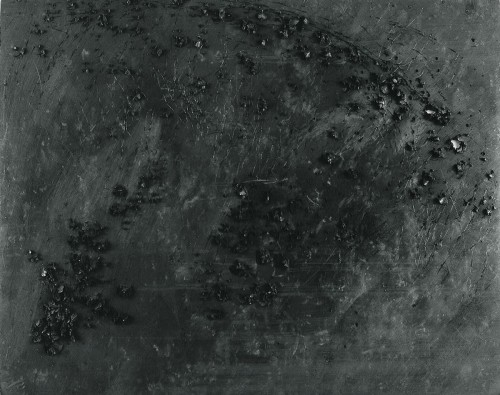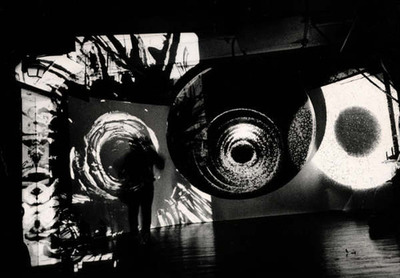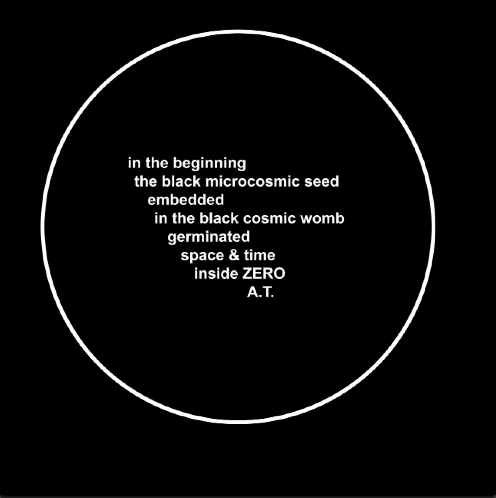Aldo Tambellini is an experimental artist working in performance, film, video, sound, painting, sculpture, and poetry. He is perhaps best known for his explorations of the color and concepts surrounding black, and his electromedia performances. His most well-known performance series grew out of previous performances titled Black (which premiered in 1965 at the International House at Columbia University) and culminated as Black Zero in 1968 (at the Brooklyn Academy of Music). Black Zero has extensively evolved through new iterations for over 40 years, including at Performa 2009 in New York, and its most recent adaptation will be featured at the Tate Modern in London from October 9 – 14 this year.
Aldo, currently 82 years young and based in Cambridge, MA, is experiencing a revived interest in his work. This well-earned and long-overdue appreciation follows his reunion in 2005 with his personal art archives, which he has been estranged from since 1971—when the commercial success of Pop Art, AbEx, and Hollywood films seemed to muffle the artists and innovators who instigated the expanded studio practices which took place in the late 1960s.
As a survivor of World War 2, a relocated Italian-American who grew up in Fascist Italy, and a witness to the New York race riots (an issue of a different kind of black altogether, which also found its way into his work), Aldo created artwork that interrogates an era in America that is frequently passed over in favor of our tendency to shine brighter distinguishing lights on our more honorable histories. Aldo’s oeuvre is fascinating, therefore, due to its demonstration of the critical gulf which consumed much of the 20th century’s most innovative artworks, but also—in a way that ties into my interests in this column—its crucial historical relevance to the development of those contemporary experimental artworks that merge sound and visual media.
Following is an excerpt of an interview conducted earlier this week with Aldo Tambellini and his companion (and archivist) Anna Salamone.

Aldo Tambellini. Black 4 from the "Black Is" series, 1989. Wax, graphite with perforations on cardboard. 31 x 39 in.
Amelia Ishmael: I would like to start by asking you, could you tell me about the origins of Black Zero?
Aldo Tambellini: I can’t tell you about Black Zero unless I tell you the beginning, which was called Black. […] When I came to New York I ended up working with black without thinking why. There was something about the area I was in, in the Lower East Side. Somehow, spontaneously, my work began to be a circular in form, and black. […] I was doing sculpture, and then I was also doing painting, which was black.
I was friends with the black poets [Ishmael Reed and Norman Pritchard], and I said, “I want you to read poetry.” […] I was making slides [lumagrams], large slides to project, and they were all hand painted and black. I said, “Maybe when you do the poetry, I’ll do some projection and we’ll make a performance.” That’s how it started. And it was called Black. […] Black also had a dancer, Carla Black. […] And the performance went very well and somebody saw it […] and said “I’d like you to do this again Aldo, in a small theater in the Lower East Side,” which was called the Bridge. So I did that. And every time I did Black I changed it. It became like a work in progress. And this went on for a long time, and each time it changed. One time it was called Black 2 and I had a big article in the Herald Tribune from New York, and the article was called “Rebellion in Art Form, Tambellini Black 2.” I’d always have an avant-garde jazz musician, never played melody at all, just very far-out improvisations.
And I continued to do this thing until it became Black Zero.
AI: And then later you would perform it at the experimental venue for performance, installation, and film you opened. Could you tell me about Gate Theater?
Aldo: My companion Elsa and I were living together, and we opened up a theater in the lower east side in the middle of the 60s, called the Gate Theater, […] and everyday we did a program that was an hour and a half of experimental film. […] The theater seated about 200 people and it was always filled. The program including some of my films. We only charged a dollar and a half. And then on the weekend we had a group called Theater Ridiculous. They were mostly people […] from [Warhol’s] Factory […]. We were very open in the thinking we were doing. Do you know who Stan Brakhage is, the filmmaker? We used to show a lot of Brakhage. We never showed Warhol, no. And then we had Jack Smith. Jack Smith was also part of the Theater Ridiculous, he used to be there live every weekend. […] There’s a whole history of that time, you know.
And then upstairs there was a larger room, it must have been something for dance, for rehearsal or something, it was like a platform and painted black. There were no lights, but there were a lot of outlets in the wall. Do you know the artist Otto Piene, from Germany? He became a good friend of mine. There’s some similar connection, between him and I. He had a group called Zero in Germany and later became the director of the Center for Advanced Visual Studies at MIT, and that’s the reason why I ended up in Cambridge. He asked me to become a Fellow, and I was a Fellow for eight years working at the place there, which was more like engineers and artists working together. He and I opened up the Black Gate upstairs and we had very experimental kind of work. […] Not everyday, only every so often. […].
[…] Do you know who Nam June Paik is? […] He was a good friend of mine. He did some at the Black Gate, but no video. And Charlotte Moorman, you know, they used to work together.
AI: Could you tell me about your background in sound, and how you incorporate sound in your films, particularly in the Black Films?
AT: Well… when I was at Syracuse University in the 1950s, […] I took a course from a musician, a woman who was from Vienna, and she was a student of Schoenberg, one of the modern musicians. […] She used to play the records and then talk about them. […] She played Stravinsky, and she played Alban Berg, and she played Varese. Varese was a French composer and the piece that she played was called “Ionisation,” and that piece, which is a very modern piece, has a siren in it—like the rarrrr-rarrrr-rarrrrrr!—which was kind of unusual for me. I began to realize later on that he was obviously influenced by the Futurists because it’s a concrete sound—it’s not played by an instrument. So he mixed that with sounds played by instrument.
My first videotape was actually shining light directly on the camera. And if you do that, direct light will make black spots on the camera. From there on everything you do that comes out is going to have black spots in the visual. So I did that. […] I found out there was a place by the airport in New York, it was called Video Flight […] They were making film into video, for the airplane. So I went there, and while they were making a copy of my first video I saw a different kind of pattern, an electronic pattern coming out, which was the electronic machine “understanding.” The machine understood this electronic pattern and it was making it to regular copy. And I said, “Would it be okay if I came back and I took some of those electronic images.” They said that was fine. So I went there and there were copies of these electronic images and I began to improvise sound with my voice, like ohohohoooooo—ahwwwwaaaaoaaa. Totally improvised as I was watching. That became the soundtrack!
Then I made another video tape and someone made me a [an instrument] and they were moderating the sound as I was doing it, in other words— switching the needle there, so that the sound would be modulated. It was all an experiment. I don’t consider myself a musician. […] It came naturally.
And I also had a lot of friends who were musicians. Mostly jazz though, avant-garde jazz. And then I knew people who did the electronic also.
AI: It seems like in the 60s a lot of artists who were collaborating and incorporating musicians in their work were largely gravitating towards Rock music. I was curious, what drew you to jazz?
AT: When I was in New York in the 60s there used to be a radio station […] in Manhattan, they used to play jazz a certain time of the week. And the disc jockey used to explain the history of jazz, he used to explain about the musicians, and gave a lot of educational ideas. So I learned a lot, but I was also interested because to me, it was the real American music. It was not European music and it came from black people originally, from the slavery time, and then began to change. […] But I never was interested in Rock n’ Roll or the Beatles or the Rolling Stones. No, no. They’re nice, they’re pleasant, but I consider […] jazz a creative form that came […] not because [the musicians] went to college to study music and all that, but it was a natural kind of development and became more and more complex until the 60s when they had free jazz, which became the most avant-garde popular jazz. […] I don’t know how to explain it, but somehow the Rock music never got me excited. I listened to it, I heard it, but I’m definitely with the jazz and maybe electronic music. Rock n’ Roll to me was always a performance kind of art more than a musician kind of an art […]
AI: Could you tell me about the upcoming event in London?
Anna Salamone: He was asked to create a site-specific installation, and it was to bring out the feeling of the 60s again. So Aldo has just found–we found, with the curators from Italy—a whole other group of films that Aldo had never shown, they’re short pieces. Some of these are going to be incorporated into this new installation. It will have film, it will have some of the sounds that we have from these recordings that we found, and it will have hand painted slides that have never been shown before—that were never part of part of the previous performances. So that’s a brand new installation, but it again reflects the 60s. I think that what they wanted to do with the Tate is to show, historically, how Aldo was the first one working with these primitive—you know when you consider digital now, and what you can do with cameras and performances—he worked manually and in a primitive way to obtain his effects. And lots of the sounds in Black Zero are actually very primitive sounds. One of them is a drill, someone was using a drill on a cheese grater, if you can believe it, and another was a vacuum cleaner, the sound of the swooshing of air from the vacuum cleaner. And there’s a large inflatable balloon, a black balloon on which we project slides. It’s a weather balloon. So there are going to be seven people actually handling the projections of the slides from seven different projectors going on at one time.
AT: I want to read something here, one second. […] This is a quotation from Aleksei Leonov, he was a Russian cosmonaut, he was the first human being to walk in space. […] He said:
Before me blackness, an inky black sky studded with stars that glowed, but did not twinkle; they seemed immobilized. Nor did the sun look the same seen from earth, it had no aureole or corona; it resembled a huge incandescent disk that seemed embedded in the velvet black sky of outer space. Space itself appears as a bottomless pit. It will never be possible to see the cosmos the same way on earth.
And all of the astronauts after him have talked about the void, how black the space is, this sense of black never seen before in their whole life. And that kind of black, while I was already doing black for a long time, I was very excited […]








Pingback: Screening 'BLACK TV REMAKE' at GEMAK by E. Fardjadniya | EhsanCritiqueEhsanCritique